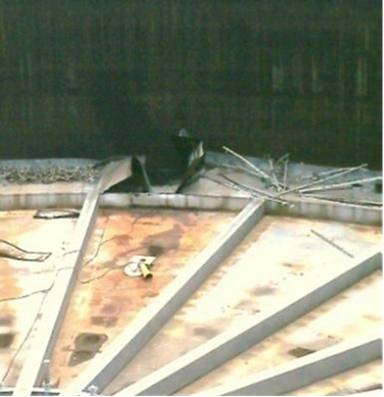
Incident Report Subject: OGP Safety Alert - PONTOON COMPARTMENT EXPLOSION ON FLOATING ROOF TANKS Date of Email report: Thu 27/03/2014 Report Detail: An explosion occurred at a location during restoration activities on a crude oil tank which had been cleaned up (Figure 1). Two workers were carrying out hot work on the top of the tank floating roof (cutting rim seal brackets in close proximity to the pontoon). One of the pontoon compartments exploded. Flammable residue was released onto the tank floor causing a small fire. In this case, workers sustained moderate injuries. However similar accidents (e.g. Figure 2) involving hot work on floating roofs after tank clean-up have taken place in the past and led to more severe injuries and fatalities. What Went Wrong? Ignition sources generated by the hot work came in contact with the flammable mixture of hydrocarbons inside a nearby pontoon compartment that was contaminated. • Tank Cleaning activities had been executed by contractors with little / no experience with tank cleaning
Corrective Actions and Recommendations: Have engagement sessions with staff to increase awareness on risks related to tank cleaning and hot work inside, on or near tanks. • Tank cleaning activities are critical operations that require specialized interventions using detailed procedures. Safety Alert Number: 255 OGP Safety Alerts http://info.ogp.org.uk/safety/ OGPDisclaimer: Whilst every effort has been made to ensure the accuracy of the information contained in this publication, neither the OGP nor any of its members past present or future warrants its accuracy or will, regardless of its or their negligence, assume liability for any foreseeable or unforeseeable use made thereof, which liability is hereby excluded. Consequently, such use is at the recipient's own risk on the basis that any use by the recipient constitutes agreement to the terms of this disclaimer. The recipient is obliged to inform any subsequent recipient of such terms. This document may provide guidance supplemental to the requirements of local legislation. Nothing herein, however, is intended to replace, amend, supersede or otherwise depart from such requirements. In the event of any conflict or contradiction between the provisions of this document and local legislation, applicable laws shall prevail. Additional Documentation:
|

